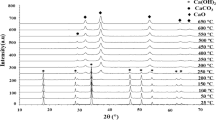Abstract
The physicochemical characteristics and cytotoxicity of two types of commercial nickel oxide particles (black and green nickel oxide) and five types of nickel oxide particles prepared by calcination of the black nickel oxide at 600–1000°C were studied. Thermal analysis with mass spectroscopy showed that the black nickel oxide particles contained approximately 1.4% impurity, which seemed to be basic nickel carbonate. The calcination treatment at 600°C increased the nickel content and decreased the oxygen content, but these remained constant in the particles treated at higher temperatures (700–1000°C) and in the green nickel oxide particles. The water solubility of black nickel oxide particles was markedly greater than that of the other particles, especially in the first 24 h after mixing with water. The solubility of the calcined particles decreased with increasing calcination temperature. The cytotoxicity of these particles was evaluated by the viability of rat alveolar macrophages and by the inhibition of cell proliferation in Chinese hamster ovary cells. The black nickel oxide was the most cytotoxic of the particles examined, and this may be attributable, at least in part, to a rapid dissolution of nickel from the contained impurity. The toxicity of the calcined particles decreased with increasing calcination temperature. These results indicate that water solubility, which depends on calcination temperature, modulates the acute cytotoxicity of nickel oxide particles.
Similar content being viewed by others
References
F. W. Sunderman, Jr., A review of the metabolism and toxicology of nickel,Ann. Clin. Lab. Sci. 7, 377–398 (1977).
V. Bencko, Nickel: a review of its occupational and environmental toxicology,J. Hyg. Epidemiol. Microbiol. Immunol. 27, 237–247 (1983).
P. Grandjean, Human exposure to nickel,IARC Sci. Publ. 53, 469–485 (1984).
H. Savolainen, Biochemical and clinical aspects of nickel toxicity,Rev. Environ. Health 11, 167–173 (1996).
IARC, Nickel in the human environment,IARC Sci. Publ. 53, 123–127 (1984).
J. K. Dunnick, J. M. Benson, C. H. Hobbs, F. E. Hahn, Y. S. Cheng, and A. F. Eidson, Comparative toxicity of nickel oxide, nickel sulfate hexahydrate, and nickel subsulfide after 12 days of inhalation exposure to F344/N rats and B6C3F mice,Toxicology 50, 145–156 (1988).
J. K. Dunnick, M. R. Elwell, J. M. Benson, C. H. Hobbs, F. F. Hahn, P. J. Haly, et al., Lung toxicity after 13 week inhalation exposure to nickel oxide, nickel subsulfide, or nickel sulfate hexahydrate in F344/N rats and B6C3F1 mice,Fundam. Appl. Toxicol. 12, 584–594 (1989).
J. M. Benson, D. G. Burt, Y. S. Cheng, F. F. Hahn, P. J. Haley, R. F. Henderson, et al., Biochemical responses of rat and mouse lung to inhaled nickel compounds,Toxicology 57, 255–266 (1989).
P. J. Haley, G. M. Shopp, J. M. Benson, Y. S. Cheng, D. E. Bice, M. I. Luster, et al., The immunotoxicity of three nickel compounds following 13 week inhalation exposure in the mouse,Fundam. Appl. Toxicol. 15, 476–487 (1990).
J. M. Benson, R. F. Henderson, and R. O. McClellan, Comparative cytotoxicity of four nickel compounds to canine and rodent alveolar macrophages in vitro,J. Toxicol. Environ. Health 19, 105–110 (1986).
J. M. Benson, R. F. Henderson, and J. A. Pickerell, Comparative in vitro cytotoxicity of nickel oxide and nickel-copper oxides to rat, mouse and dog pulmonary alveolar macrophages,J. Toxicol. Environ. Health 24, 373–383 (1988).
A. P. Wehner, R. H. Busch, R. J. Olson, and D. K. Craig, Chronic inhalation of nickel oxide and cigarette smoke by hamsters,Am. Ind. Hyg. Assoc. J. 36, 801–810 (1975).
F. W. Sunderman, Jr., Carcinogenicity of nickel compounds in animals, inNickel in the Human Environment, F. W. Sunderman, Jr., ed., Oxford University Press, Oxford, pp. 127–142 (1984).
F. W. Sunderman, Jr., S. M. Hopfer, J. A. Knight, K. S. McCully, A. G. Cecutti, P. G. Thornhill, et al., Physicochemical characteristics and biological effects of nickel oxides,Carcinogenesis 8, 305–313 (1987).
F. W. Sunderman, Jr., S. M. Hopfer, M. C. Plounmann, and J. A. Knight, Carcinogenesis bioassays of nickel oxide and nickel copper oxides by intramuscular administration to Fisher-344 rats,Res. Commun. Chem. Pathol. Pharmacol. 70, 103–113 (1990).
A. Horie, J. Haratake, I. Tanaka, Y. Kodama, and K. Tsuchiya, Electron microscopical findings with special reference to cancer in rats caused by inhalation of nickel oxide,Biol. Trace Element Res. 7, 223–239 (1985).
J. Haratake, A. Horie, Y. Kodama, and I. Tanaka, Histopathological examination of rats treated by inhalations of various types of nickel compounds,Inhalat. Toxicol. 4, 67–79 (1992).
S. Takahashi, M. Yamada, T. Kondo, H. Sato, K. Furuya, and I. Tanaka, Cytotoxicity of nickel oxide particles in rat alveolar macrophages cultured in vitro,J. Toxicol. Sci. 17, 243–251 (1992).
M. Yamada, S. Takahashi, H. Sato, T. Kondo, T. Kikuchi, K. Furuya, et al., Solubility of nickel oxide particles in various solutions and rat alveolar macrophages,Biol. Trace Element Res. 36, 89–98 (1993).
M. Ooishi, S. Takahashi, T. Kikuchi, and K. Furuya, Solubility of two types of nickel oxide particles in mouse respiratory tract and in five kinds of solvents,Kankyo Kagaku (Environ. Sci. Jpn.) 8, 397–408 (1995) (in Japanese with English abstract).
Author information
Authors and Affiliations
Rights and permissions
About this article
Cite this article
Takahashi, S., Oishi, M., Takeda, E. et al. Physicochemical characteristics and toxicity of nickel oxide particles calcined at different temperatures. Biol Trace Elem Res 69, 161–174 (1999). https://doi.org/10.1007/BF02783867
Received:
Accepted:
Issue Date:
DOI: https://doi.org/10.1007/BF02783867




